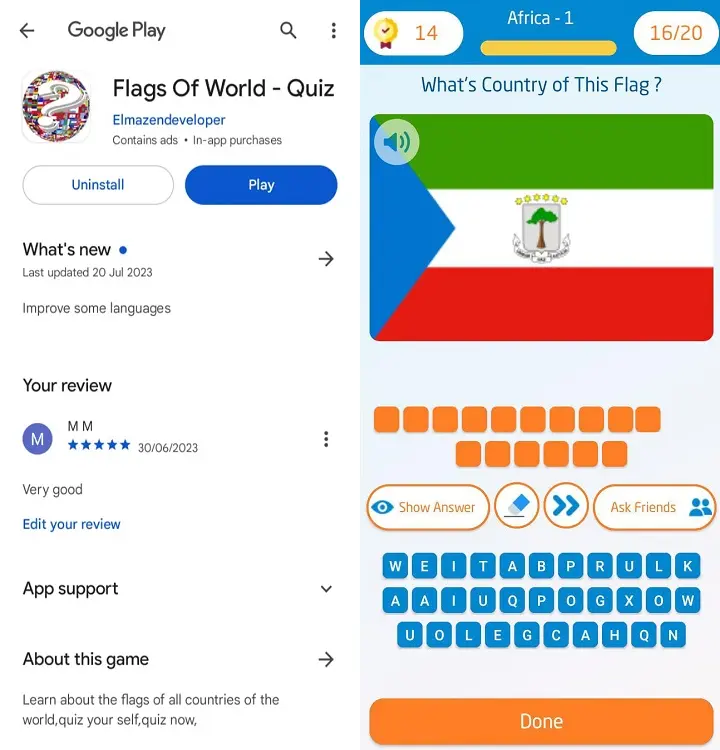Equatorial Guinea Flag, Currency, Population, Tourist Places
Equatorial Guinea: A Hidden Gem in Central Africa
Discover Equatorial Guinea: capital, tourist places, population, flag, currency
Equatorial Guinea, a small nation in Central Africa, is a unique blend of mainland territory and five enchanting islands.
Despite its size, the country is one of Africa’s richest, thanks to its abundant natural resources, particularly oil and gas.
However, the true treasure lies in its vibrant culture, rich history, and breathtaking landscapes, making it a destination worth discovering for adventurous travelers seeking unparalleled experiences.
Equatorial Guinea Flag, Currency, Population, Tourist Places

Download the application  Flags Of World - Quiz ,
Flags Of World - Quiz ,
And test your knowledge with Flags of World ,
Tourist Attractions in Equatorial Guinea
Equatorial Guinea offers a remarkable variety of attractions that cater to all kinds of travelers.
From historical architecture and cultural museums to lush tropical forests and serene beaches, the country boasts a plethora of must-visit sites.
Here are some of the top destinations:
Capital of Equatorial Guinea
Malabo: The Captivating Capital
Located on the island of Bioko, Malabo is a charming city that combines historical allure with modernity.
Visitors can marvel at the Catedral de Santa Isabel, a neo-Gothic architectural masterpiece, and explore the Cultural Center, which hosts exhibitions and events celebrating the nation’s heritage.
Another highlight is the Malabo National Park, a lush retreat featuring a botanical garden and a zoo.
For those who enjoy nightlife, Malabo offers an array of lively bars, clubs, and restaurants that cater to diverse tastes.
Monte Alen National Park: A Natural Wonderland
Monte Alen National Park, situated in the mainland region, is a haven for wildlife enthusiasts and nature lovers.
Spanning over 1,400 square kilometers, the park is home to an impressive array of species, including gorillas, chimpanzees, elephants, crocodiles, and countless bird species.
The park also features hiking trails, camping facilities, and guided tours, offering visitors an immersive experience in one of Africa’s most biodiverse regions.
Bata: The Modern Hub
As the largest city on the mainland, Bata serves as a dynamic and cosmopolitan center, equipped with a bustling port, an international airport, and a prominent university.
The city is also rich in historical and cultural landmarks, such as the Bata Cathedral, the Freedom Tower (Torre de la Libertad), and the Ethnographic Museum, which showcases the country’s diverse cultural heritage.
Additionally, Bata is a gateway to nearby beaches like Arena Blanca and Utonde, where visitors can relax and enjoy picturesque views.
Annobon Island: A Paradise for Nature Enthusiasts
Nestled in the Gulf of Guinea, Annobon Island is a dream destination for nature lovers and adventure seekers.
This volcanic island features rugged landscapes, dense vegetation, and stunning panoramic views.
It is home to some of Equatorial Guinea’s most beautiful beaches, such as Playa de Agua Dulce and Playa de los Cocoteros, where turquoise waters and soft sands await.
The island also boasts a rich cultural tapestry influenced by Portuguese and Afro-Brazilian traditions, making it a unique and enriching place to visit.
Equatorial Guinea Flag, Currency, Population, Tourist Places

Download the application  Flags Of World - Quiz ,
Flags Of World - Quiz ,
And test your knowledge with Flags of World ,
Fascinating Facts About Equatorial Guinea
Equatorial Guinea is a land of rich history, diverse culture, and unique identity.
Here are some intriguing facts about the country:
Population and Ethnic Diversity
As of January 2025, Equatorial Guinea has an estimated population of 1.91 million people.
Its population comprises various ethnic groups, including the Fang, Bubi, Ndowe, and Bisio.
The country’s official languages are Spanish, French, and Portuguese, but several local languages, such as Fang, Bube, and Annobonese, are also widely spoken.
The National Flag
Equatorial Guinea’s flag features horizontal stripes of green, white, and red, with a blue triangle at the hoist and the national coat of arms in the center.
Each color carries significant meaning:
- Green represents the country’s natural resources, agriculture, and lush forests.
- White symbolizes peace and unity.
- Red honors the sacrifices of those who fought for independence.
- Blue reflects the sea, which connects the mainland to the islands.
Currency and Economy
The country uses the Central African CFA franc (XAF) as its official currency.
This currency is shared with five other Central African nations, including Cameroon, Chad, and Gabon.
The CFA franc is pegged to the euro at a fixed exchange rate of 1 euro = 655.96 CFA francs, providing stability to the economy.
Why Visit Equatorial Guinea?
Equatorial Guinea is a country that deserves greater recognition on the global stage.
Despite its challenges, it has emerged as a nation with a unique blend of tradition and progress.
The country’s abundant natural beauty, combined with its rich cultural heritage, offers visitors an unforgettable journey.
Beyond its wealth of natural resources, Equatorial Guinea is a land of extraordinary contrasts.
From its bustling cities to its tranquil beaches, and from its verdant rainforests to its volcanic islands, there is something here for everyone.
Whether you are a history enthusiast, a culture lover, or an adventure seeker, this hidden gem in Central Africa promises a rewarding and enriching experience.
Equatorial Guinea is not just a destination it’s a story waiting to be told, a culture to be embraced, and a beauty to be explored.
So, if you’re seeking an off-the-beaten-path adventure, make Equatorial Guinea your next destination.
Equatorial Guinea Flag, Currency, Population, Tourist Places
